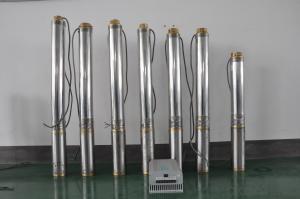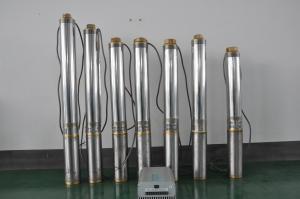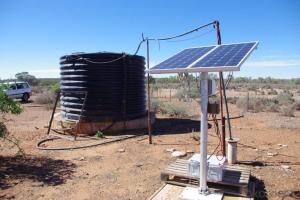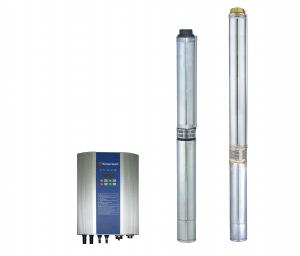3TSS/4TSS SOLAR PUMP stainless steel CE, solar panel
- Loading Port:
- Shanghai
- Payment Terms:
- TT OR LC
- Min Order Qty:
- 50 pc
- Supply Capability:
- 100000 pc/month
OKorder Service Pledge
OKorder Financial Service
You Might Also Like
1.APPLICATION AREA:This project products are mainly used in dry region for irrigation of agriculture, It can be used for drinking water and
living water. The living condition could be much improved. It also can be used for fountains.2.MATERIAL OF PARTS:Outlet: stainless steel
Pump body: stainless steel
Motor body: stainless steel
Bearing: C&U
3.ADVANCED TECHNOLOGY:1.Application innovation
Compared with the traditional alternating current machine, the efficiency is improved 25% by the permanent magnetism, direct current, brushless, non-sensor motor.
2.Technics innovation
Adopt double plastic package for rotor and stator, motor insulation≥300MΩ, the motor security was much improved.
3.Structure innovation
Oil filling, convenient installation and environmental protection4.HIGHLIGHTSa.Energy-saving and environment-protected green products
b.High technique products adopting MPPT and DSP chip technique.
c.100% copper wire, cold-rolled silicon steel sheet
d.CE certificate
e.Advanced three phase brushless DC motor
f.Stainless steel 316 screws
g.3 years warranty5.PRINCIPLE OF OPERATION:Solar panel collects sunlight→DC electricity energy → solar controller(rectification,stabilization,amplification,filtering)→available DC electricity→(charge the batteries)→pumping water6.ADVANTAGES OF SOLAR PUMP SYSTEM:A.It is easier and more widely used than any other dynamoelectric driven pumps.
B.It is more economical and more environmentally friendly.7.MODEL SELECTION:a.The power of solar panel = power of pump ×1.3
The voltage of solar panel = the voltage of pump
The controller should be matched
b.Select the batteries according to the following formulas:
The use hour of battery =
The battery capacity ÷(the machine power÷the battery voltage)×0.6 For example,the machine power is 200W, the battery
capacity is 100AH,the voltage is 12V,and the battery is fully charged,then the use hour is:100÷(200÷12)×0.6=3.6hours
c.The battery capacity=
the use hour ÷0.6×(the machine power÷the battery voltage) For example,the machine power is 200W,the battery voltage
is 12V,and the battery need to be used for 3.6hours,then the battery capacity is:3.6÷0.6×(200÷12)=100AH

- Q:Can a solar pump be used in areas with limited access to water distribution?
- Yes, a solar pump can be used in areas with limited access to water distribution. Solar pumps are designed to operate using energy from the sun, making them a sustainable and cost-effective solution for areas where conventional electricity or water distribution systems are lacking. These pumps can be installed in remote locations and can draw water from underground sources such as wells or boreholes, ensuring a reliable water supply for communities with limited access to water distribution infrastructure.
- Q:How do solar pumps compare to diesel or electric pumps in terms of efficiency?
- Solar pumps are generally more efficient than diesel or electric pumps. Solar pumps are powered by sunlight, which is a renewable and free energy source. They do not require any fuel or electricity to operate, resulting in lower operational costs and reduced carbon emissions. In contrast, diesel pumps require fuel, which can be expensive and contribute to pollution. Electric pumps may rely on grid electricity, which can be unreliable or unavailable in remote areas. Overall, solar pumps offer a more sustainable and cost-effective solution for pumping water.
- Q:Can a solar pump be used for both residential and commercial purposes?
- Yes, a solar pump can be used for both residential and commercial purposes. Solar pumps are versatile and can be installed in various settings, making them suitable for both small-scale residential applications, such as garden irrigation or water supply, as well as larger-scale commercial uses like agricultural irrigation, livestock watering, or industrial water management. The ability to harness the power of the sun makes solar pumps an environmentally friendly and cost-effective option for both residential and commercial users.
- Q:How does a solar pump handle water with high levels of fluoride or other chemicals?
- A solar pump itself does not handle water with high levels of fluoride or other chemicals. It is primarily responsible for pumping water from a source, such as a well or a borehole, using solar energy. However, if the water being pumped contains high levels of fluoride or other chemicals, additional water treatment methods or systems would be required to handle the specific water quality issues.
- Q:Can a solar pump be used to pump other liquids besides water?
- Yes, a solar pump can be used to pump other liquids besides water. The functionality of a solar pump remains the same regardless of the liquid being pumped. However, it is important to consider the compatibility of the pump materials with the specific liquid to avoid any damage or deterioration.
- Q:Can a solar pump be used for water circulation in a fish pond or aquaponics setup?
- Yes, a solar pump can be used for water circulation in a fish pond or aquaponics setup. Solar pumps are a great option for these applications as they utilize the sun's energy to power the pump, making them environmentally friendly and cost-effective. The water circulation is crucial in a fish pond or aquaponics setup as it helps to maintain the water quality and oxygen levels required for the health and well-being of the fish and plants. Solar pumps can be used to create water movement, aerate the water, and ensure proper filtration, all of which are essential for a successful fish pond or aquaponics system. Additionally, solar pumps can be easily installed and require minimal maintenance, making them an ideal choice for these setups.
- Q:Can a solar pump be used in areas with limited access to water treatment plants?
- Yes, a solar pump can be used in areas with limited access to water treatment plants. Solar pumps are advantageous in such areas because they operate using solar energy, eliminating the need for grid connectivity or fuel. These pumps can draw water from various sources such as boreholes, wells, and rivers, and can be used for irrigation, livestock watering, and domestic water supply. While solar pumps do not treat the water, they can efficiently transport it to a central location where it can be treated or used for various purposes.
- Q:Can a solar pump be used in combination with a storage tank?
- Certainly, a storage tank can be used in conjunction with a solar pump. In fact, utilizing a storage tank alongside a solar pump can greatly enhance the utilization of solar energy and guarantee a consistent water supply. When a solar pump is employed, the sun's energy powers the pump, enabling it to transfer water from a source (such as a well or a river) to a desired location. By connecting the solar pump to a storage tank, surplus water can be stored during times of abundant sunlight and subsequently utilized during periods of reduced sunlight or increased water demand. The storage tank functions as a reservoir for storing water that has been pumped by the solar pump. This ensures an uninterrupted water supply, even during nighttime or cloudy days when the solar panel may not generate sufficient energy to power the pump. The water stored in the tank can be employed for various purposes, including irrigation, livestock watering, or even household usage. Furthermore, the combination of a storage tank and a solar pump helps to mitigate the impact of fluctuations in water availability. It provides a buffer, allowing water to be stored during times of abundance and used during periods of scarcity. This can be especially advantageous in regions with seasonal variations in water availability or unreliable water sources. In conclusion, the integration of a storage tank with a solar pump is a practical and efficient solution for optimizing the use of solar energy and ensuring a consistent water supply. It allows for water to be stored during periods of ample sunlight and used during times of reduced sunlight or increased water demand, guaranteeing a continuous water supply regardless of fluctuations in solar energy availability.
- Q:How does the type of solar panel (monocrystalline, polycrystalline, thin-film) affect the performance of a solar pump?
- The type of solar panel used in a solar pump, whether it is monocrystalline, polycrystalline, or thin-film, can significantly impact its performance. Monocrystalline solar panels are made from a single crystal structure, which allows them to have higher efficiency and better performance in low-light conditions. This means that a solar pump equipped with monocrystalline panels can generate more electricity and operate more efficiently, even under cloudy or shaded conditions. Polycrystalline solar panels are made from multiple crystal structures, resulting in a slightly lower efficiency compared to monocrystalline panels. However, they are still capable of providing adequate power for a solar pump, especially in regions with ample sunlight. Thin-film solar panels are the least efficient of the three types, but they have advantages in terms of flexibility and cost-effectiveness. They can be easily integrated into various surfaces and are less expensive to produce. However, due to their lower efficiency, a solar pump using thin-film panels may require a larger surface area to generate the same amount of power as monocrystalline or polycrystalline panels. In summary, the type of solar panel used in a solar pump affects its performance by influencing its efficiency, ability to generate electricity in low-light conditions, and cost-effectiveness. Monocrystalline panels offer the highest efficiency, while polycrystalline panels strike a balance between efficiency and cost. Thin-film panels are more flexible and cost-effective but have lower efficiency.
- Q:Can a solar pump be used in areas with limited access to water distribution networks?
- Yes, a solar pump can be used in areas with limited access to water distribution networks. Solar pumps are designed to operate independently of grid electricity and can be installed in remote locations where there is limited or no access to traditional water distribution systems. These pumps use solar energy to power their operation, making them a sustainable and reliable solution for accessing water in areas with limited infrastructure.
1. Manufacturer Overview |
|
|---|---|
| Location | |
| Year Established | |
| Annual Output Value | |
| Main Markets | |
| Company Certifications | |
2. Manufacturer Certificates |
|
|---|---|
| a) Certification Name | |
| Range | |
| Reference | |
| Validity Period | |
3. Manufacturer Capability |
|
|---|---|
| a)Trade Capacity | |
| Nearest Port | |
| Export Percentage | |
| No.of Employees in Trade Department | |
| Language Spoken: | |
| b)Factory Information | |
| Factory Size: | |
| No. of Production Lines | |
| Contract Manufacturing | |
| Product Price Range | |
Send your message to us
3TSS/4TSS SOLAR PUMP stainless steel CE, solar panel
- Loading Port:
- Shanghai
- Payment Terms:
- TT OR LC
- Min Order Qty:
- 50 pc
- Supply Capability:
- 100000 pc/month
OKorder Service Pledge
OKorder Financial Service
Similar products
New products
Hot products
Related keywords




























